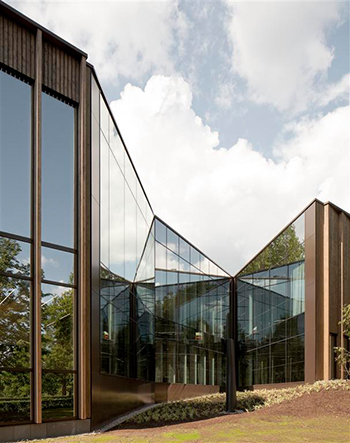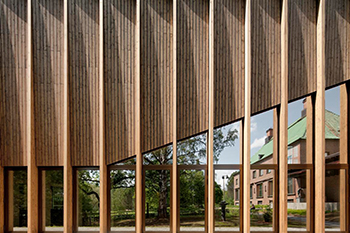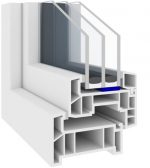Kommerling warm edge system, Ködispace 4SG, has been used in a recent extension to the Gösta Serlachius Museum in Finland. The Gosta Pavilion is the latest addition to the home of the industrialist and art collector, Gosta Serlachius. Designed by Spanish architect, MX-SI, the extension’s structure consists of 100 parallel laminated timber frames, interspersed by high windows.
The pavilion, which took 18 months to construct, is 135m long and 17m high at its maximum height. It is joined to the Serlachius private family residence, a brick house with a copper roof, by a glass corridor. The addition of this new building has reportedly increased the museum space by 500m², to a total of 1.500m², and it houses both a permanent exhibition of the Gost Serlachius art collection alongside varying exhibitions by both Finnish and international artists.
The warm edge system
The silicone-sealed glass panels in the project were manufactured by Finnish company, Seloy, with specialist sealant made by Kommerling. The bonded elements conceal a special warm-edge system, which thanks to flexible edging, is said to be equal to the wild temperature extremes of the local climate. At the heart of the sealing process is a separator called Ködispace 4SG.
According to Kommerling, the warm-edge system menas that insulation panes are ‘extraordinarily’ robust, resilient and durable and also ideally suited for the physical requirements of structural glazing.
Glass with aesthetic properties
Ködispace 4SG is said to considerably enhance the aesthetic properties of glass elements; there are no ‘ugly’ separator displacements in the three-ply insulation panes or disruptive light reflections that can be caused by metal parts. The black sealant ensures that the space between panes is almost invisible and sight lines from within the museum are unhindered, giving the impression of a ‘fluid transition’ between the building and its surroundings.


Q&A with Dr. Knut Göke, product manager at KÖMMERLING Chemische Fabrik GmbH
GGP: What sort of problems can arise with glass facades?
KG: The extreme temperatures occurring in the faces cause the insulation glass to expand and pull together again, thus exposing the edging to enormous stresses. If the sealant is not able to accommodate this movement and instead compensates for them, the seal becomes leaky, hence elasticity of the sealant is a significant precondition for permanently, well-sealed insulation glass. If the seal cannot be maintained then there is a risk of loss of gas and thermal insulation. Material incompatibility among the adhesives and sealants used and in interactions between construction materials deployed can also cause additional problem, which in the worst case scenario can lead to expensive and hazardous structural damage.
GGP: Why is Ködispace 4SG so well suited to structural glazing?
KG: Black polyisobutylene is extruded from the barrel direct on to the disc to create a well-sealed, homogeneous separator. In the process it replaces primary sealant, metallic separator and desiccant. Its special formulation allows it to form a chemical bond with the glass and secondary sealant silicone. The overall edging remains permanently elastic and gas-tight over the long term. Kommerling also offers suitable secondary sealants that are fully compatible and thus provide a reliable and safe warm-edge system.
GGP: How has this sealant benefited the Gosta pavilion?
KG: Serious cold puts additional strain on glass. The warm edges of Ködispace 4SG are great at surviving the severe sub zero temperatures of the Finnish winter without any problems. It is clear that this climate places great demands on thermal glass insulation and its durability. Without the appearance of an unsightly separator, the warm edge approach allows the interesting architectural design to deliver maximum impact.
Source: Glass & Glazing Products, issue October 2016
The last crime figures show that the police registered exactly 167,136 burglaries in Germany last year. Which means that another flat is ransacked every three minutes on average. Doors and windows are frequently exploited vulnerabilities for break-ins. But the protection from burglars can be markedly improved by gluing.
The annual number of burglaries has been on the increase again for a while, most recently by nearly 10 percent in 2015. The perpetrators very often break into flats and houses by prying open a window. A simple screwdriver will suffice to do this with standard windows. Leverage is applied to design-related vulnerabilities: the connections between the glazing and casement, between the casement and window frame, and between the window frame and wall.
Tested resistance classes
A remedy is provided by anti-burglary windows with demonstrably tested resistance classes. Which is also why the police is recommending components rated RC2 or higher. But a window will only prevent intrusion if the safety chain formed by the bonding of the glass, rebate area and connection to the wall is completely closed and the entire system meets the requirements of the desired resistance class.
Glued all around
What this means for the glass bonding is that glass strips need to be screwed or glued in place to make the grade. A far better solution for this is to glue the insulating glass into the casement, however, because the circumferential bond will fuse them into a single entity.
Only a small number of glazing blocks will now be required for load transfer, if any at all. This eliminates a leverage point for prying the window open at the glass joint. The gluing additionally improves the statics of the entire casement, which is rendered torsion-resistant and virtually impossible to twist. The consequence: A burglary tool applied to only a single point of the window will be unable to gain enough leverage for bending the casement. The gluing hence not only strengthens the glass joint, but indirectly also the connection between the casement and window frame.
The recommended RC2 resistance class is furthermore reached with particular ease if the insulating glass is glued to the casement. This offers tangible advantages for window makers and fitters: The blocking is reduced or even done away with entirely, with no separate fastening of glass strips required. All the window needs now is the right RC2 fitting, and appropriate installation at the building site. In addition, this can also be done using profiles with no additional steel reinforcements.
Polyurethane glue meets the requirements
To be recommended as an optimal antiburglary solution is the gluing position at the base of the rebate with a polyurethane adhesive called Ködiglaze P from Kömmerling. This can not only be used for RC-gluing to plastic profiles, but also all the other commonly used frame materials such as wood, wood/aluminium and aluminium, for example. The glue is available in a one-component version in 600 ml sausages or also in a two-component version for application with mixing and dispensing systems.
Glued to the rebate base
The bonding with the rebate base achieves the best statics: As opposed to glass edge bonding, the casement will not require additional overlaps for reinforcement. The PUR adhesive furthermore achieves a high mechanical stability and is hard to cut. It can even be used to provide RC2-compliant fixed glazing directly at the building site. The one-component adhesive is easy to handle, enabling the insulating glass to be glued into the ready-assembled frame on site without difficulties.
To ensure a permanently secure bond, the manufacturer’s adhesives are compatible with most insulating glass sealants available on the market. This also means that they are attuned to the commonly used polysulphide- or polyurethane-based insulating glass sealants in their chemical as well as mechanical properties. These materials are furthermore compatible with the commercially available PVB films used to increase the glazing’s anti-burglary effect from resistance class RC2.




